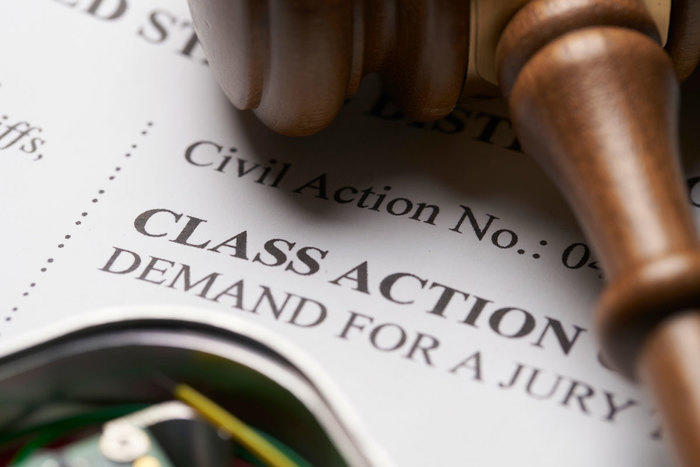Legal Understanding: Browsing the Landscape of Class Action Lawsuit Instances
Wiki Article
Comprehending Course Activity Legal Action: A Guide for Attorney
Course action claims have come to be an important component of the legal landscape, permitting for the loan consolidation of multiple claims into a solitary action. By diving into the ins and outs of class action legal actions, this guide outfits lawyers with the understanding and tools needed to efficiently navigate this complicated location of law.The Fundamentals of Course Activity Suits
Course activity suits are a lawful device employed to combine comparable claims from a group of people right into a solitary suit, supplying a efficient and economical strategy to seeking justice and resolution. This sort of claim permits a depictive plaintiff, acting on behalf of the entire course, to bring a case versus a defendant who has supposedly created harm or breached the legal rights of multiple people.The standard demands for bringing a class activity claim consist of numerosity, commonness, typicality, and competence of representation. Numerosity refers to the reality that the course need to be so large that joinder of all participants would be unwise. Commonness suggests that there have to prevail questions of law or fact that are shared by all participants of the course. Typicality calls for that the cases of the depictive complainant are normal of the insurance claims of the whole class. Finally, adequacy of representation ensures that the representative complainant will adequately represent the interests of the whole course.
Class activity suits can be useful for both plaintiffs and accuseds. For offenders, it offers the chance to successfully deal with numerous claims in a single claim, avoiding the requirement to safeguard versus numerous private legal actions.
Identifying and Assessing Potential Class Participants
After developing the basic requirements for a class activity legal action, the following step is to determine and examine possible course participants. This process includes establishing that may become part of the course and reviewing their claims to identify if they satisfy the needed standards.To recognize possible course members, lawyers typically carry out substantial study and collect appropriate info. This may include evaluating files, conducting interviews, and examining records to recognize people or entities that might have been impacted by the supposed wrongdoing. It is essential to establish a comprehensive and clear checklist of possible class members to make certain that all influenced celebrations are consisted of in the legal action.
Once possible class participants have been identified, the following step is to examine their insurance claims. This involves examining the advantages of each individual insurance claim to identify if they fulfill the legal needs for class qualification. Attorneys have to thoroughly assess the truths, proof, and legal theories of each possible class member's case to ensure that they have a feasible instance.
Evaluating prospective course participants also includes determining whether they meet the class definition and have experienced similar damage as a result of the defendant's activities. This calls for comparing the truths and scenarios of each potential class member's circumstance to the claims and lawful theories put forth in the claim.
Browsing the Course Certification Process
To effectively navigate the course qualification procedure, lawyers must vigilantly abide by the step-by-step needs stated by the court. Course qualification is a vital action in a course action claim, as it figures out whether an instance can continue as a course activity, standing for a group of individuals who have similar claims against a defendant. The process involves pleasing details standards, such as numerosity, commonality, typicality, and adequacy of representation.Firstly, lawyers have to establish numerosity by demonstrating that the course is so large that individual joinder is not practical. This calls for an extensive evaluation of the claims and defenses involved.
Following, attorneys must show typicality, which implies that the representative plaintiff's cases are regular of the cases of the course participants. This ensures that the passions of the depictive plaintiff line up with the passions of the course. Lawyers must show competence of depiction, meaning that the representative complainant and their advise will rather and properly represent the rate of interests of the class.
To navigate this procedure efficiently, lawyers have to completely prepare by performing extensive research, gathering proof, and establishing a compelling argument that satisfies each of these criteria. They have to additionally be prepared to reply to any difficulties or objections raised by the defendant. By faithfully sticking to the procedural needs established forth by the court, legal representatives can enhance their chances of acquiring class accreditation and progressing the rate of interests of the course members.

Key Techniques for Managing Class Action Lawsuits
Upon effectively browsing the class accreditation procedure, legal representatives should after that implement crucial strategies for successfully taking care of class action lawsuits. These approaches are important to make certain that the case proceeds smoothly and successfully, ultimately making best use content of the chances of a desirable result for the class participants.
One secret strategy is to establish a strong and cohesive legal group (Class action lawsuit). This involves putting together a team of lawyers with proficiency in class action litigation, in addition to various other pertinent locations such as the details sector or subject involved in the instance. A versatile group can bring various viewpoints and abilities to the table, boosting the total performance of the lawsuits
An additional vital approach is to create a thorough and well-balanced lawsuits plan. This plan ought to describe the overall objectives of the click here for more case, as well as the specific lawful concepts and disagreements that will be pursued. It needs to additionally consist of a timeline and budget plan to guarantee that the case remains on track and within the allotted sources.
Furthermore, attorneys should proactively engage with the class participants throughout the litigation process (Class action lawsuit). This includes providing normal updates on the development of the case, looking for input and comments from the class participants, and dealing with any problems or concerns they may have. By cultivating open communication and cooperation, legal representatives can build count on and assistance among the class members, which can be important in attaining an effective resolution
Working Out Course Activity Claims: Arrangement and Approval
When it involves working out course action suits, efficient settlement and obtaining approval are crucial actions in attaining a resolution. Class activity lawsuits are complicated and entail a multitude of complainants, making it crucial to reach a negotiation that is reasonable and adequate to all events involved.
Once a negotiation agreement is reached, it useful link needs to be authorized by the court. The court's duty in this procedure is to make certain that the settlement is fair, reasonable, and sufficiently shields the passions of the course participants. The court will consider factors such as the nature of the claims, the strength of the evidence, the possible recuperation for the course participants, and any type of objections increased by class members.
Obtaining court authorization is critical as it gives finality to the negotiation and secures the rate of interests of the class members. It ensures that the negotiation is binding and enforceable, and course members can receive their rightful compensation.
Verdict

Course action legal actions have actually become an indispensable part of the lawful landscape, enabling for the combination of numerous insurance claims right into a single activity. Class qualification is a crucial action in a class activity lawsuit, as it determines whether an instance can proceed as a class activity, representing a team of individuals that have similar insurance claims versus a defendant. By carefully adhering to the procedural needs set forth by the court, attorneys can raise their chances of acquiring course certification and advancing the passions of the class members.
The court will certainly take into consideration elements such as the nature of the insurance claims, the toughness of the evidence, the possible recuperation for the class members, and any type of arguments raised by class members.
By determining and analyzing potential class members, attorneys can figure out the stability of a class action suit.
Report this wiki page